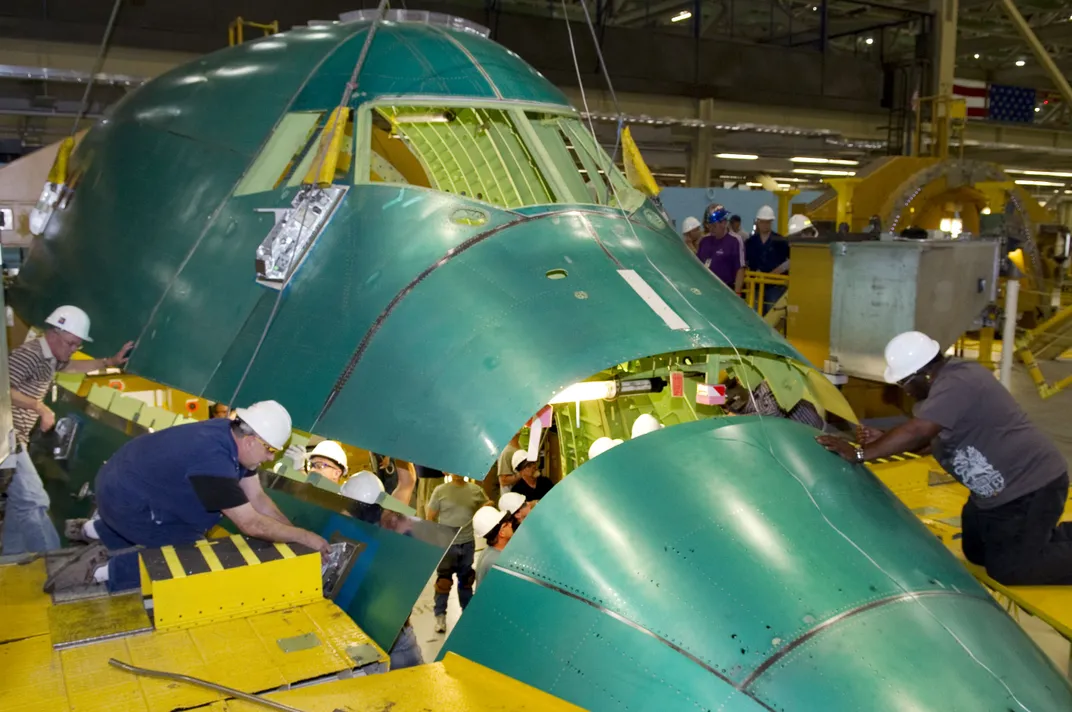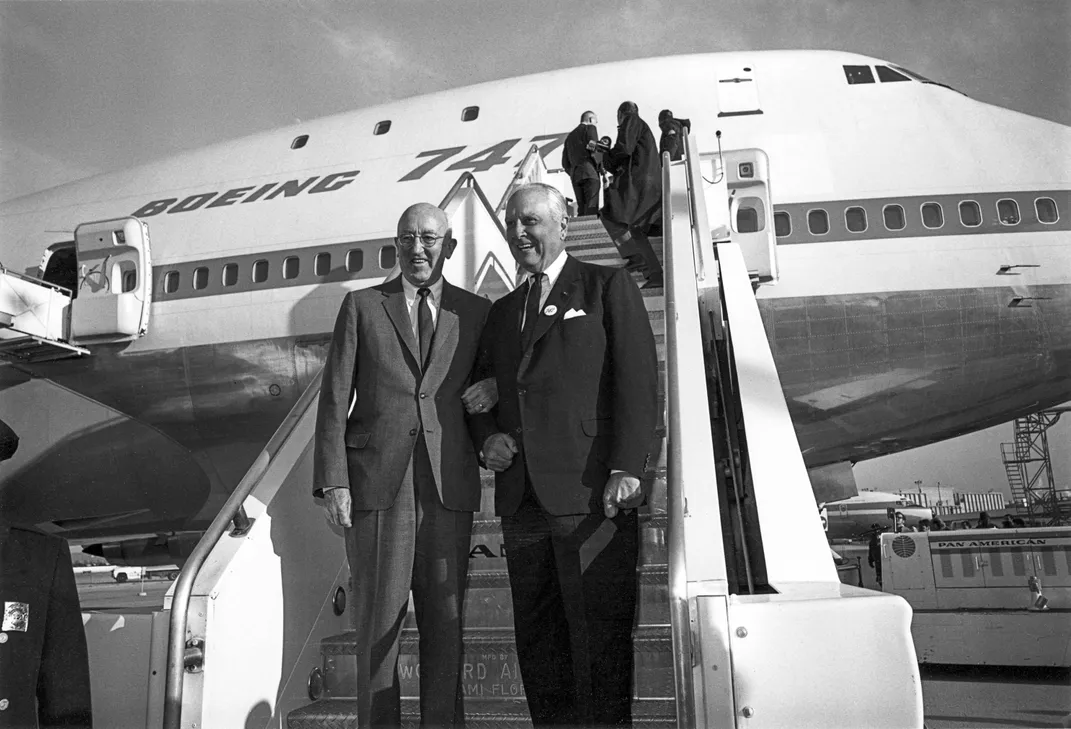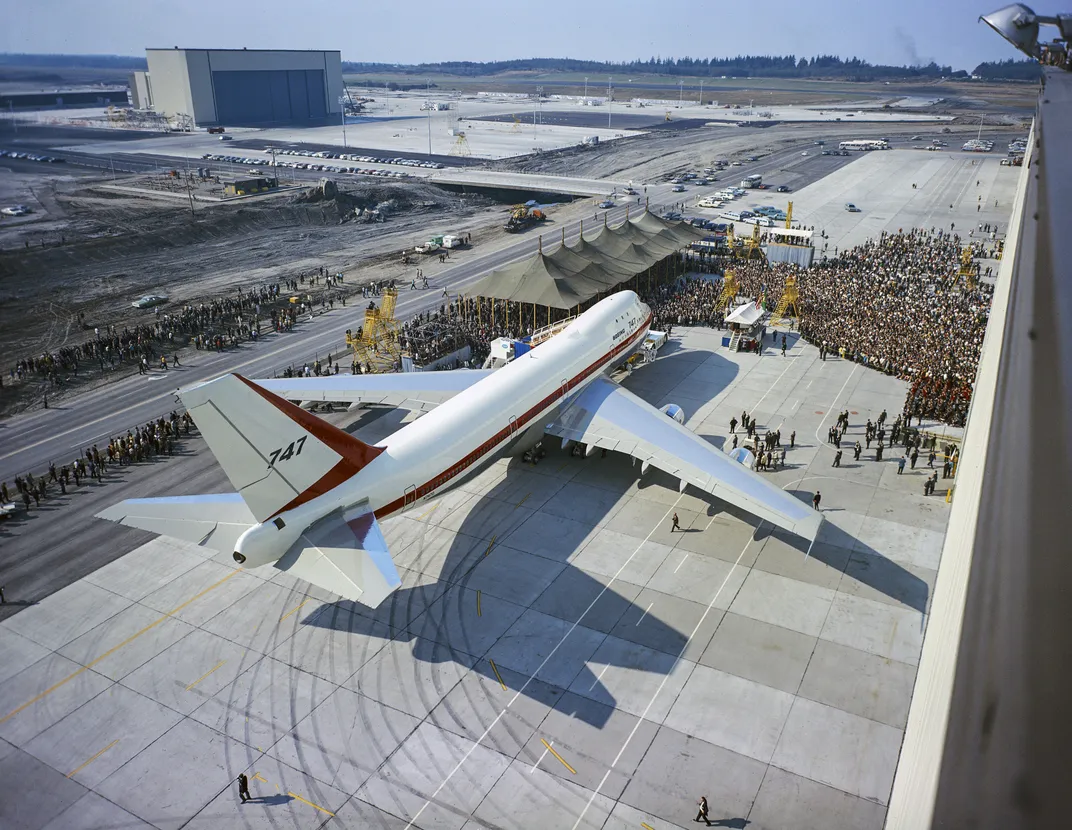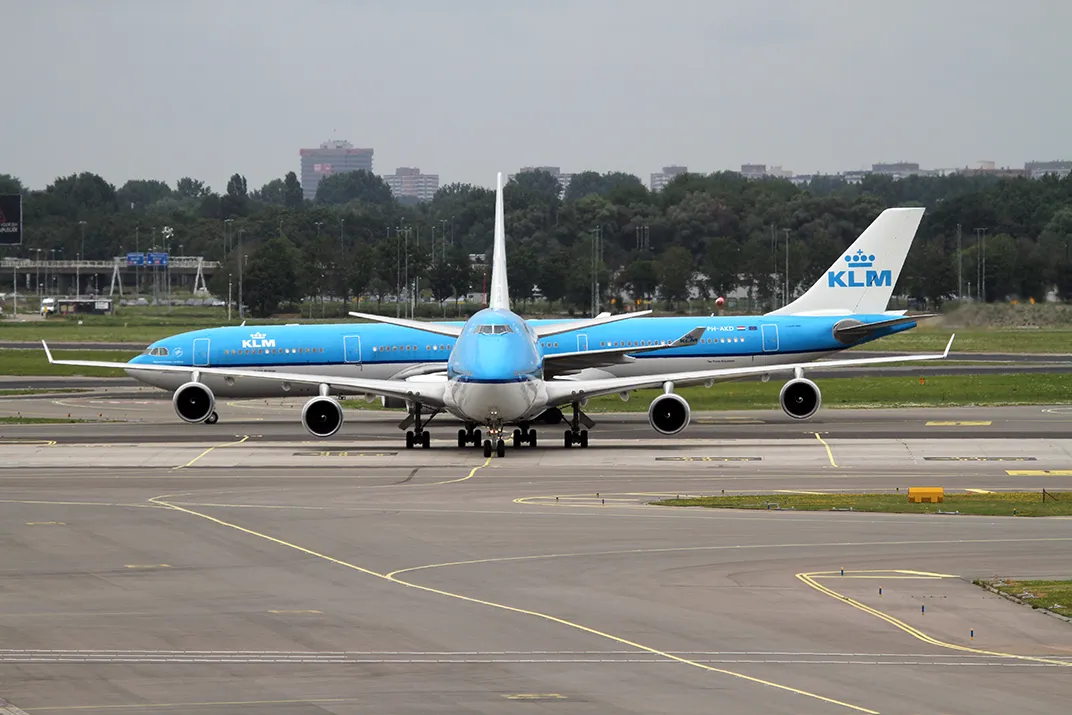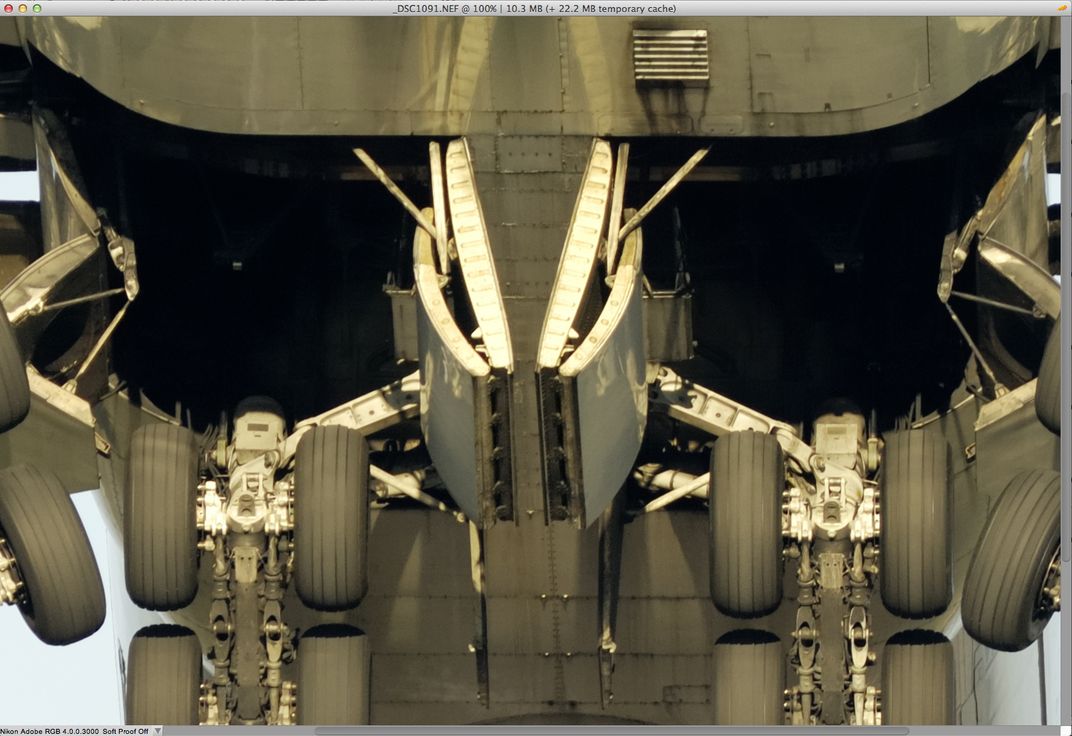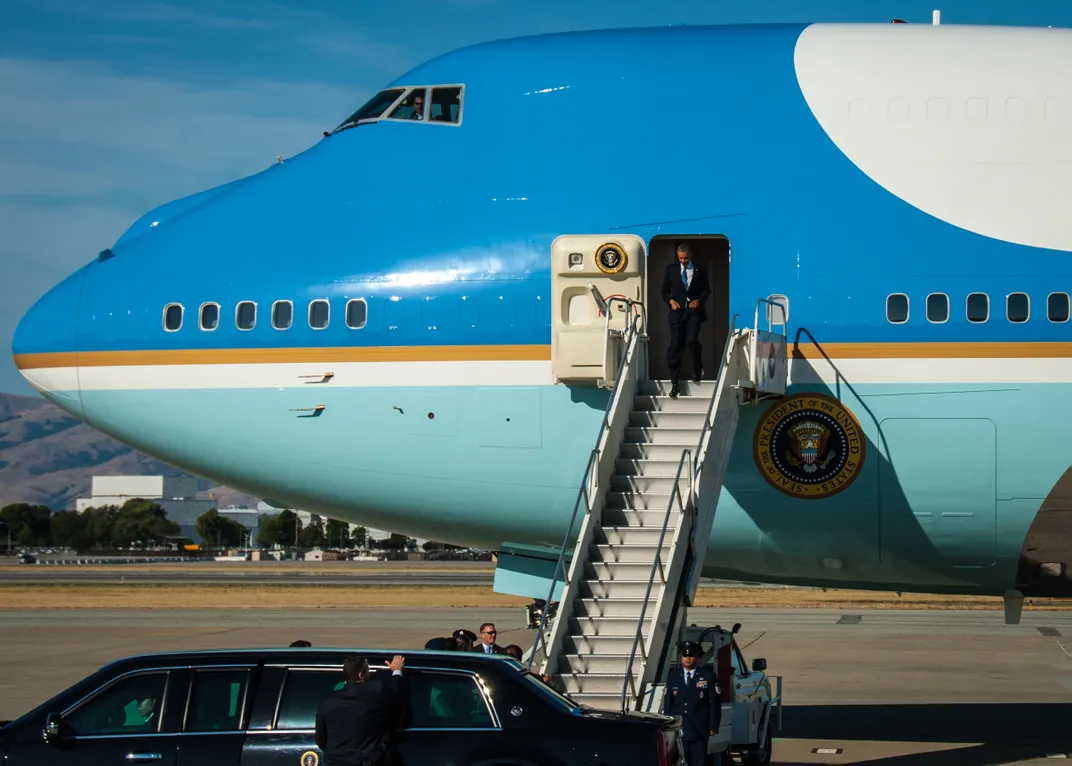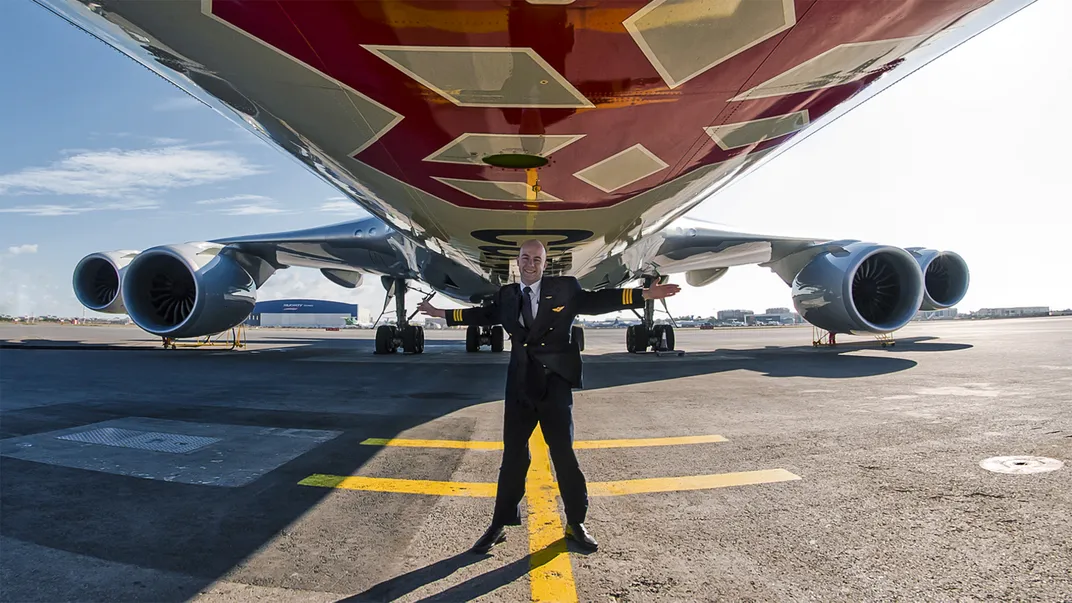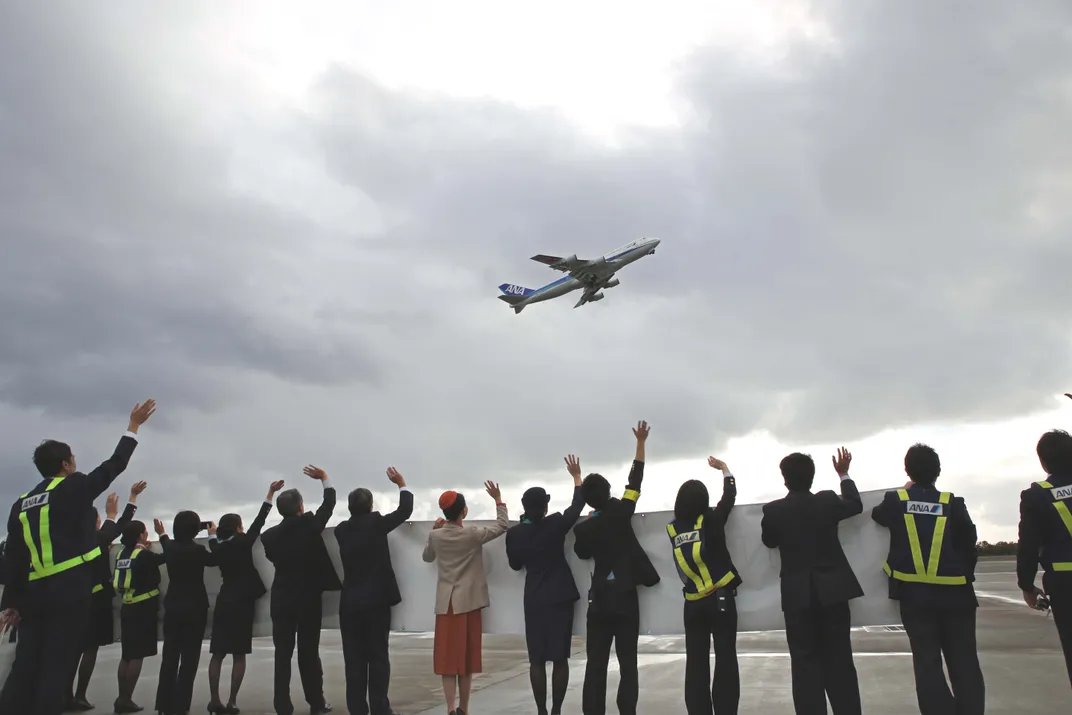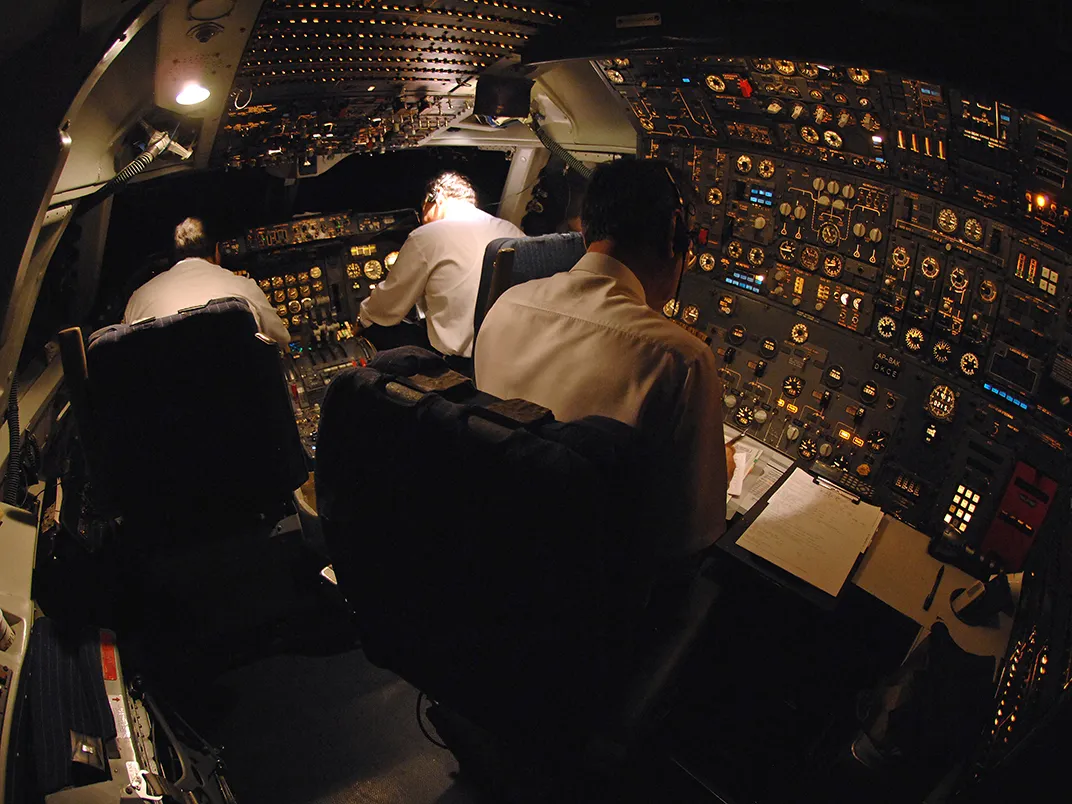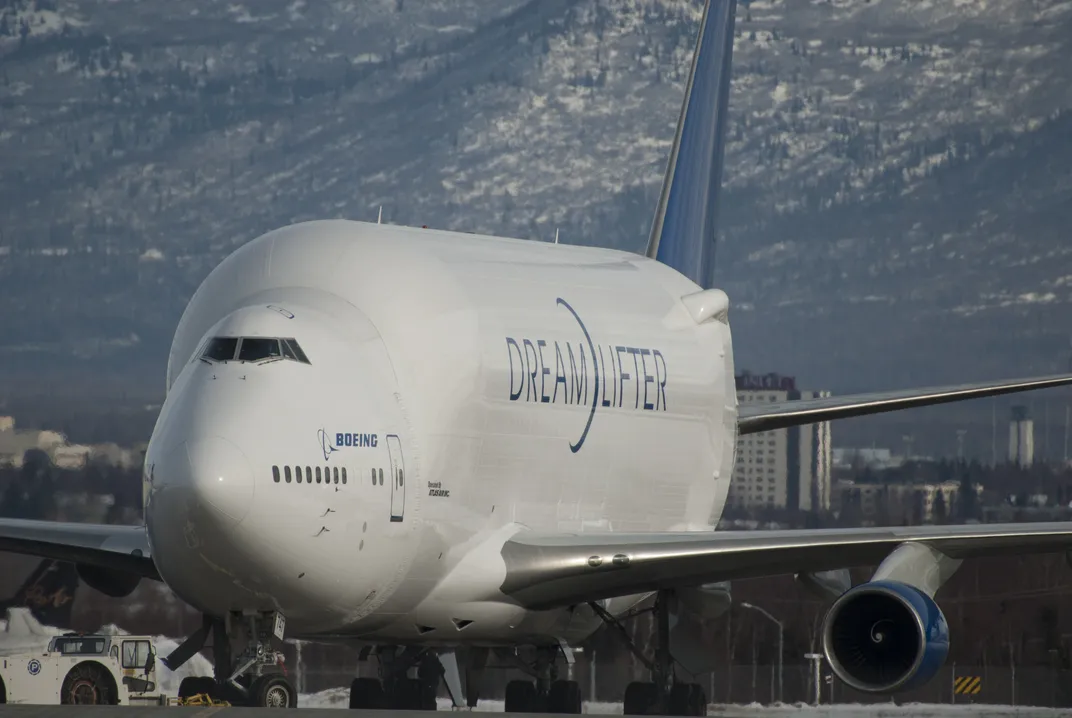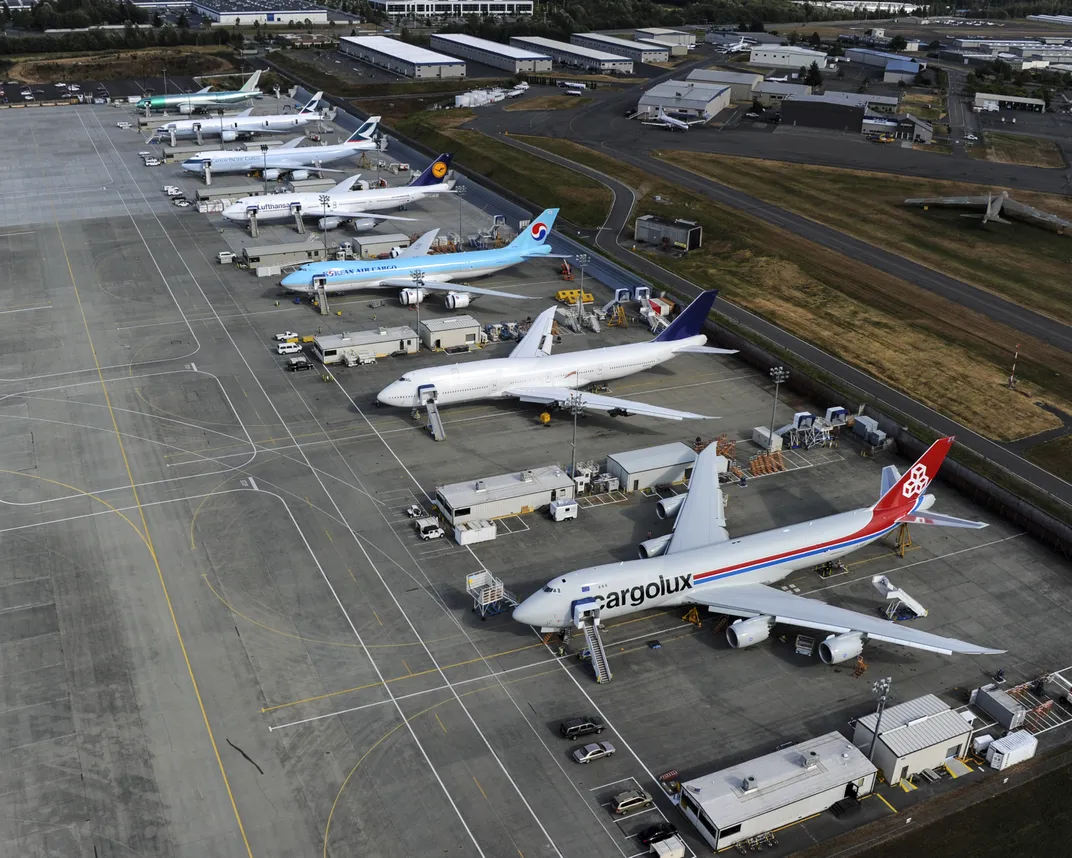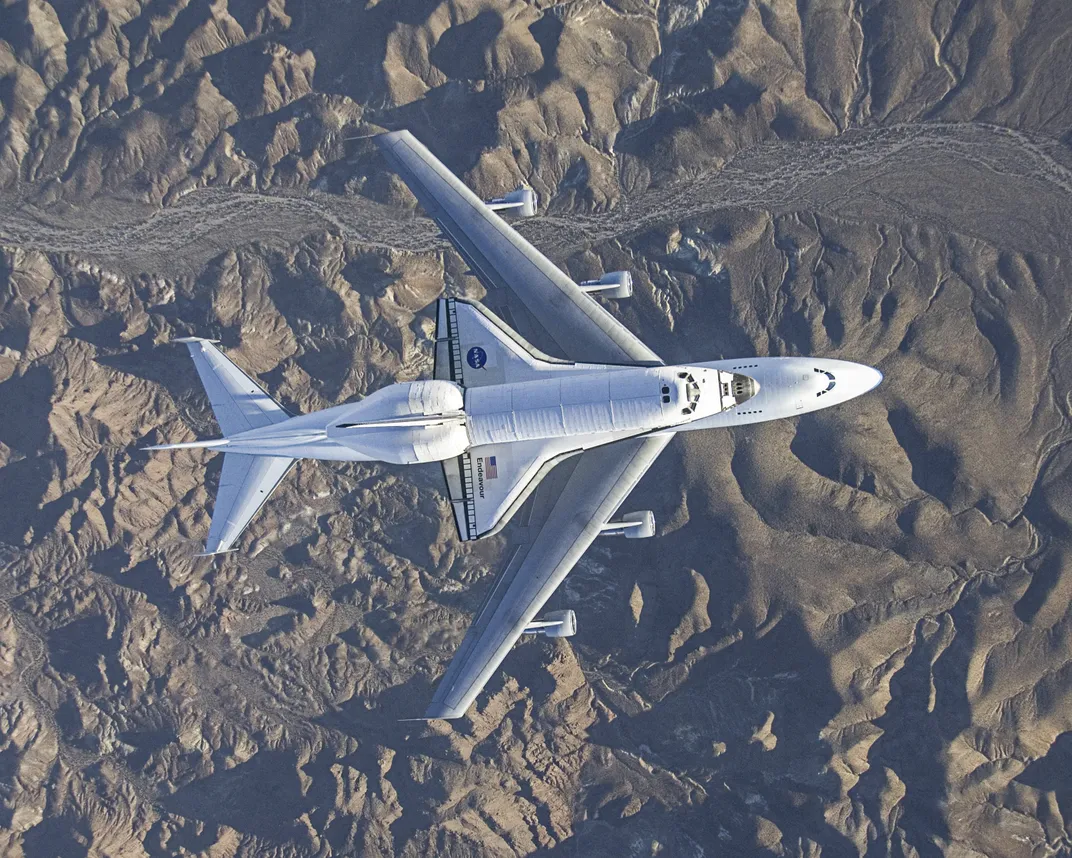747: The World’s Airliner
The first jumbo jet has transported the equivalent of 80 percent of the human race.
/https://tf-cmsv2-smithsonianmag-media.s3.amazonaws.com/filer/78/cd/78cd8261-cec9-49b4-b660-7269fd9b43a3/15zc_jj14_rawvsofimagew_4369_live.jpg)
March 31 marked the end of an aviation era in Japan. That day, the last of the country’s passenger-carrying Boeing 747s landed at Tokyo’s Narita airport. Over the previous six months, All Nippon Airways had sent its 747-400s on a series of farewell tours, following by several years the final flights of Japan Airlines’ jumbo jets.
“I thought it was a wonderful aircraft. There is no comparison,” says ANA’s chief executive officer, Osamu Shinobe, of the decision to drop the 747. “I feel so sad to see its retirement.” But emotions are no match for economics, and the Japanese carriers join many others in ridding their fleets of the four-engine jumbo that gulps too much fuel and requires too many passengers to fill.
“Like a good car, when it gets old and it’s time to replace it, you get sad, of course,” says Austin Cheng, president of Taiwan’s EVA Air, which, along with Air New Zealand, Cathay Pacific, Air India, British Airways, and Qantas, has been swapping 747s for smaller twin-engines like Boeing’s 777 and 787 and the soon-to-be-flying Airbus A350 XWB (“XWB” for “extra wide-body”).
“The 747 is plummeting out of service far faster than anyone would have expected,” says Richard Aboulafia, an airline analyst with the Teal Group in Washington, D.C.
Still, perhaps no airliner past or present is likely to be more fondly remembered by the people who built it, the executives who bought it, the employees who worked on it, or the passengers who flew in it across the globe for 44 years.
“I loved it for the spaciousness. I loved it for the walk-through galleys,” says Candice Kimmel, a flight attendant on the 747s flown by Pan Am World Airways in the 1970s. “I loved it for the innovative things you could try because there was so much space.”
When the 747 entered service, in 1970, space was the thing that stupefied everyone, says Robert van der Linden, curator of the air transportation division at the National Air and Space Museum. “That airplane came out and it was two and a half times larger” than the Boeing 707. “It dwarfed everything.”
I remember my first 747 flight on Virgin Air from New York City in 2001. My employer had sprung for a premium seat, not first class but large enough to feel comfortable. I was tucked up on the left side of the upper deck with a window seat. I felt above it all long before we took off for London.
Don Wolfe, who has 10,000 hours in the 747 flying for United, says he is still amazed by the view as he sits in the cockpit before taking off. “My eyes are 29 feet off the ground. We have a guide man 150 feet in front of the airplane, and when I look down at that guy, I cannot believe how high I am sitting.”
For Wallace Moran, who flew the 747 for Trans World Airlines for 12 years before retiring in 2002, the height was the pilot’s greatest challenge. “You can look over the top of most terminal buildings, which is kind of a neat thing. But when you look down at those taxiways they look pretty small, pretty narrow.”
Cargolux pilot Christiaan van Heijst says the 747 “is a pilot’s dream. It flies very nicely and it’s not any more difficult than any other Boeing aircraft to handle with the exception of [landing in strong] crosswinds. Because of the extra engine on the wing, if you bank too much during landing you run the risk of a so-called ‘pod strike’ or scraping the outer engine on the ground. It’s the queen of the skies but sometimes a bitch to land in cross-wind conditions.”
The 747’s size distorted the sensation of speed in the cockpit, Wolfe says. “Our liftoff speed is 207 mph, but it feels like we are crawling. When we raise the nose, the flight deck is high in the air before the back end comes off the ground.” Still, he says, every one of the more than 100 pilots to whom he has given check rides finds the liftoff thrilling.
“To a person, when I look over on the climbout they are smiling, because they can’t believe how cool it is to fly this airplane, and that is the truth.” Wolfe and Jim Karsh, a pilot with Delta Air Lines, continue to fly 747s because their airlines—United and Delta—are two of just a few, including Lufthansa, Korean Air, and Saudi Arabian, that have decided to keep the airplane.
Delta acquired its 16 jumbos in 2009 when it merged with Northwest. Nat Pieper, Delta’s vice president of fleet strategy, says at the time, executives took a hard look at how much life was left in the -400s, which ranged in age from seven to 20 years, and asked, “How much would it cost when the time came for heavy maintenance?” and “What was the economic benefit of owning the airplanes?”
“We pay attention to the ownership and the fixed cost when we are evaluating the cost of operating the 747 between now and the end of the decade,” Pieper explains. “Yes, a Boeing 777 or an A330, a twin- versus a four-engine, is much more fuel-efficient, and the maintenance cost is less as well. But we sleep well at night because we know what the ownership advantage is” in having perhaps the world’s most recognizable airliner.
Delta, in fact, plays up the 747’s glamour. It has 1,300 airliners in its fleet, and most of them look the same. But the 747, Pieper says, is “a great flagship.” Many of the airline’s ads feature the airplane that constitutes less than one percent of the fleet.
The 747 has long been popular for making a statement. In the 1970s, celebrities were often photographed boarding the airplane. In 1986, Late Night host David Letterman chartered a TWA 747, had his show’s logo painted on the nose, and broadcast his fourth anniversary program en route from New York City to Miami.
From the 747’s first flight, in 1969, size has been the headline grabber, but airlines and passengers could also see that the 747 was shrinking the world with its then-record-breaking speed of Mach .92 and range of 5,300 nautical miles. New routes were possible, and airlines in the Pacific like Singapore and Cathay seized on the opportunities the jumbo offered. On its flights from Hong Kong to Europe, Cathay did away with the inconvenient and time-consuming refueling stops in Bahrain, says Tom Owen, senior vice president for the Americas. Soon the airline had 25 jumbo jets and was offering a daily flight to London—the first Asian carrier to do so.
The airplane was powered by a new and innovative high-bypass-fan engine—the Pratt & Whitney JT9D—that was developed for the 747’s 735,000-pound takeoff weight. Compared to its predecessors, the engine could move more payload on less fuel. When the seat-mile cost dropped, says van der Linden, air travel became affordable. The airliner “opened up air travel to millions more people because it lowered the prices,” he says.
And it gave those passengers a flight experience more chic than anything before it. “The idea of a stairway on an airplane—it spoke to style and graciousness,” says Aboulafia. “And of course the look of the plane itself. It was gorgeous.”
For Pan Am, the first airline to fly the 747, all those additional passengers prompted a frenzy of hiring. The airline wanted to match the airplane’s classy image by hiring flight attendants who were sophisticated and bilingual, so it went to college campuses to recruit them. Pan Am’s Kimmel, with a new degree in French literature, was thrilled to be hired. “The airline had an influx of new, wide-eyed, enthusiastic people,” she says. “We were giddy with excitement. I can’t help but think that rubbed off on the passengers. It was a whole exhilarating, happy time.”
But an airline’s ambitions could run ahead of practicality. The bar pianos on American Airlines’ 747s, for example, suffered cocktail spills that resulted in the need for constant tuning and cleaning. The Captain Cook lounges on the upper decks of Qantas’ jumbos were soon deemed wasteful, and carved up and refitted with business-class seats.
Some of Pan Am’s ideas also needed to be rethought, Kimmel recalls. “They decided in economy we would dish up meals from the cart, like in first class,” she says. “Forget the TV dinners where you take the foil off the top. With soup, you had to have the person on the aisle help you with the tray. If you didn’t spill it, they spilled it.” Even with the jumbo’s steadier ride, turbulence sometimes sent a dish of veal marengo sloshing—onto the floor or, worse, a passenger.
The team that designed the 747 had been led by Joseph Sutter, who in 2006 wrote the book 747: Creating the World’s First Jumbo Jet and Other Adventures From a Life in Aviation. At a dinner in his honor in November 2013, the retired Boeing engineer told me that, spilled veal dinners notwithstanding, one quality often overlooked was how well the 747 handled. His team, he said, learned “how to design an airplane that was not only efficient but could handle normal and abnormal circumstances. If there was failure or other difficulties, like weather, it still handles very well.”
Jim Karsh has flown the 747 for 18 of his 28 years as an airline pilot. “It’s a nice-flying airplane,” he says. “It is stable in rough air. It is easy to make an approach in. It’s easy to land.”
Over the years, the designation “Boeing 747” has been applied to 18 versions of the airplane—some very different in appearance and function. The wings have been lengthened, the flight engineer position removed, the front end extended, the wings given winglets and then raked tips.
The variants include passenger and cargo airplanes and the “combi,” which carries both. Two modified 747s ferried the space shuttle for NASA for 30 years, and two now haul large sections of the 787 Dreamliner to Boeing’s assembly plants in Washington state and South Carolina. Perhaps the most famous modification is the one used for VIPs. In the United States, the president flies in a 747 as Air Force One, as do the heads of state in India, Japan, Morocco, Saudi Arabia, Taiwan, and Yemen.
“The 747 got its name ‘Queen of the Sky’ for alot of reasons,” says Randy Tinseth, vice president for marketing at Boeing, “because of the way it looks and its appeal to passengers. But also because of all the things it can do. It has a place in aviation history.” He speaks with the zeal of an evangelist, but he loses me when he concludes, “and the Dash 8 will continue that legacy.” I’m skeptical because the number of orders for that airplane is so paltry.
If anybody is primed to believe in the latest version of the 747—the one with the suffix -8 (also known as the Intercontinental)—it’s Lufthansa executive vice president Nico Buchholz. In 2006, his airline became the first to order the Dash 8. The airplane was still on the drawing board and Lufthansa contributed to its design. The Dash 8 would keep the jumbo jet’s signature shape, but nearly every other important element would change. “It has a new wing. It has the most modern engine [the General Electric GEnx-2B] of any four-engine aircraft worldwide. There is a lot of new technology.”
Others don’t share the German aviation executive’s enthusiasm. Besides Lufthansa, only Korean Air, China Air, Nigeria’s Arik Air, and Russia’s Transaero are the airlines that have bought it to carry passengers. Boeing spent $4 billion developing the Intercontinental, and just 51 have been sold, according to Boeing.
Buchholz says Boeing should have promoted the airplane more vigorously. “Boeing builds brilliant aircraft, but you still need to push them into the market,” he says. “They are not purchased by themselves.”
From Boeing’s standpoint, says Tinseth, the key to bringing the 747 into the 21st century was to create an airliner with the same operating costs as the 747-400 but with greater payload capacity and range. Lufthansa began flying the Dash 8 in 2012 on routes between the United States and India. But the new passenger jumbo’s future looks doubtful.
I ask Aboulafia why an airplane so beloved seems to be flying into history. “People drew the wrong lessons,” he says. “People said ‘Look how well it sold. There’s a market.’ But they bought it for the range, not capacity.” Sure, he says, being big was news-making at the time, but what made the airplane a success was not being big, and when seats go unsold, an airline doesn’t make money. “Somehow that history got rewritten,” he says.
If there’s one aviation market where size does count, it may be cargo. Aboulafia and Tinseth agree that the future looks brighter for the Dash 8 freighter, which has 4,200 cubic feet more capacity than the -400, with space for seven additional cargo pallets. Cathay Pacific, Korean Air, Cargolux, and Nippon Cargo, among other carriers, have ordered a total of 68 Dash 8 freighters. “The freighter has done better than we anticipated, and the passenger airplane not as well as we would liked to have seen,” says Tinseth.
Deciding to retire the 747 was, for many airlines, that rare accounting decision that had to be separated from sentiment. “It will make everybody very, very sad because people are very fond of the jumbo,” Air India’s president, Rohit Nandan, says. “People love the jumbos, but of course the world changes.”
Nandan recalls that when the 747 debuted, flying was still special and the world full of inaccessible places. For more than four decades, the jumbo has given its passengers an experience unrivaled in modern air travel, one in which glamour and adventure came with the ticket.
